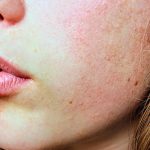Seeing your doctor for a skin cancer screening can be intimidating. A skin exam is crucial for early detection. It is a simple process that can detect skin cancer. Here is what to expect during a skin cancer screening.
Skin cancer is common in the U.S., with one in five people developing some form of skin cancer. Wearing sunscreen is not the only protection you need against. If your sun exposure is frequent you may be at a higher risk of skin cancer. It is important to have a skin cancer screening with a dermatologist.
How to prepare for your skin cancer screening
Check your skin regularly so you know what is normal and what may be a sign of cancer. If you see anything unusual, you may need to see a dermatologist sooner than your yearly exam. Be prepared to show your doctor any spots on your skin that you have concerns about or that have changed since your last exam. Make a list of skin- or skin cancer-related questions your dermatologist can answer during your appointment.
What to expect
During your skin cancer screening, you will need to change into a hospital gown. Your doctor will perform a full head-to-toe exam on your skin. Unless they notice anything unusual, this should only take about 20 minutes.
Your doctor will start by looking at every inch of your body – from your face, chest, back, arms and legs. They will also inspect less-visible spots, such as your scalp, between your toes and the soles of your feet. If you have a history of melanoma, they may also look at your lymphatic regions.
While you are with the doctor, speak up about any questions or concerns you have. Be sure to explain if you have noticed any changes in growths or moles.
What your doctor is looking for
During the skin cancer screening, your doctor is looking for the “ABCDEs” of each mole or spot. These may be signs of cancer:
- Asymmetry: Not the same shape on each side
- Border irregularity: Ragged or blurred edges
- Color: Different shades of tan, brown or black
- Diameter: Larger than 1/4 inch
- Evolving: Changing over time
If your doctor finds something
If your doctor notices any unusual spots, they may take a closer look with a dermatoscope. This tool resembles a combination of a flashlight and a magnifying glass. Your doctor may take note of the spot and photograph it to monitor it over time.
If your doctor finds a suspicious spot and wants to know more about it immediately, they will take a biopsy. It is common for the doctor to take a biopsy that same day. A dermatology biopsy involves numbing the spot and taking a small sample for analysis.
Your doctor might instead do a punch biopsy on the spot. Using a circular blade, like a hole puncher, the doctor removes deeper layers of the skin for testing. Both types of biopsy results should be available within 7 to 10 days.
If your doctor finds skin cancer, you can start treatment. It is highly treatable when discovered early. Early detection is key in skin cancer.
There are several types of skin cancer. They are indicated by an abnormal growth of skin cells.
- Basal cell carcinoma
- Squamous cell carcinoma
- Melanoma
Guidelines for skin cancer screening
If you notice any suspicious mole or spot on your skin, best be safe and see your doctor. If you have a high risk of skin cancer, you should have regular skin cancer screenings. These factors for skin cancer include fair skin, propensity for sunburns, prior skin cancer and family history.
Through regular skin self-exams, you will know your own skin and notice changes in freckles, moles or other spots. A skin self-exam is best done with a full-length mirror in a well-lit room. Use a hand-held mirror for areas that are hard to see, such as the back of your thighs. Ask a family member or friend for help with checking areas such as your scalp and back.
Carefully examine your skin to learn where your moles, blemishes, freckles and other marks are and what they look like. Each time you do a self-exam, note any moles or growths that:
- Are new
- Have changed over time
- Itch
- Bleed
During your self-exam, if any growth or mole seems odd or different to you, take photos. You can use them as a reference to see if it has changed over time. Show these photos to your dermatologist for closer inspection.
Where to get a skin cancer screening nearby
Columbia Skin Clinic’s board-certified dermatologists screen, diagnose and treat skin cancer. With four convenient Midlands locations, it has never been easier to visit a dermatologist, and it just might save your life.






